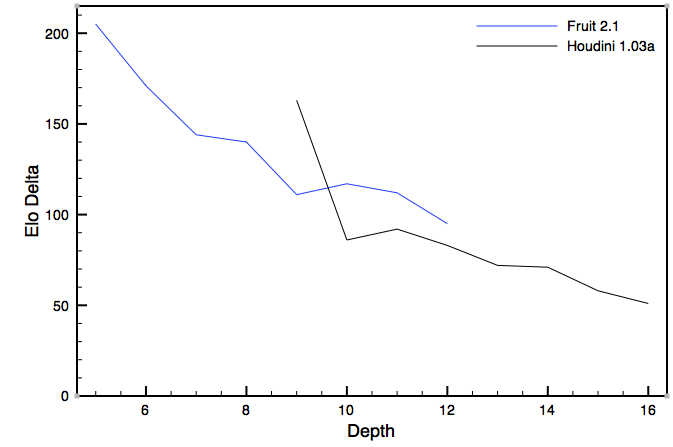Don wrote:Robert wrote:Don wrote:At low depths the amount of ELO per doubling is quite large and at high depths it is much lower.
This is true (and quite logical) and it must be dependent of your BF too.
Higher the BF => less ELO gain per doubling.
Lower the BF => more ELO gain ....
Do you agree?
I agree that the lower the BF the more ELO gain for a properly written program. In fact it is the reason today's programs are so much stronger than programs of 20 years ago is because the very low BF. We do pay for this in quality but it's an excellent trade-off.
But I'm not sure it explains the low vs high ELO gain per doubling as the BF of most program don't vary that much at high depths.
I thought that the possible explanation for this is that being able to search x+1 plies instead of x plies does not give quite as much increase in Elo as being able to search x plies instead of x-1 plies.
I have some data to share, but it is even less conclusive than I remembered.
First, here are some results from self-testing where Fruit 2.1 and Houdini 1.03 each play themselves at different depths (both were RR):
Code: Select all
Rank Name Elo + - games score oppo. draws
1 Fruit_2.1_ply12 482 18 18 1981 91% -60 15%
2 Fruit_2.1_ply11 387 16 16 1981 84% -49 19%
3 Fruit_2.1_ply10 275 15 15 1981 74% -35 20%
4 Fruit_2.1_ply9 158 14 14 1981 63% -20 21%
5 Fruit_2.1_ply8 47 13 13 1981 52% -6 20%
6 Fruit_2.1_ply7 -93 14 14 1981 39% 11 17%
7 Fruit_2.1_ply6 -237 15 15 1982 28% 30 13%
8 Fruit_2.1_ply5 -408 18 18 1982 15% 51 11%
9 Fruit_2.1_ply4 -613 24 24 1982 4% 77 6%
Rank Name Elo + - games score oppo. draws
1 Houdini_1.03a_ply16 287 8 8 3649 85% -36 28%
2 Houdini_1.03a_ply15 231 7 7 3648 79% -29 32%
3 Houdini_1.03a_ply14 173 7 7 3650 72% -22 36%
4 Houdini_1.03a_ply13 102 6 6 3648 63% -13 39%
5 Houdini_1.03a_ply12 30 6 6 3649 53% -4 36%
6 Houdini_1.03a_ply11 -53 6 6 3649 42% 7 33%
7 Houdini_1.03a_ply10 -145 7 7 3649 30% 18 28%
8 Houdini_1.03a_ply9 -231 8 8 3649 20% 29 21%
9 Houdini_1.03a_ply8 -394 10 10 3649 7% 49 12%
There seems to be a trend where the Elo delta decreases as the depth increases, but not conclusively.
The next piece of data is a comparison of move selections made by Gaviota 0.84 when restricted to different depths. I randomly selected 1000 positions from the positions that come with the sim tool, then modified the tool so that it gave "go depth x" instead of "go infinite":
Code: Select all
Key:
1) Gaviota 0.84 depth 02(time: 50 ms scale: 1.0)
2) Gaviota 0.84 depth 03(time: 50 ms scale: 1.0)
3) Gaviota 0.84 depth 04(time: 50 ms scale: 1.0)
4) Gaviota 0.84 depth 05(time: 50 ms scale: 1.0)
5) Gaviota 0.84 depth 06(time: 50 ms scale: 1.0)
6) Gaviota 0.84 depth 07(time: 50 ms scale: 1.0)
7) Gaviota 0.84 depth 08(time: 50 ms scale: 1.0)
8) Gaviota 0.84 depth 09(time: 50 ms scale: 1.0)
9) Gaviota 0.84 depth 10(time: 50 ms scale: 1.0)
10) Gaviota 0.84 depth 11(time: 50 ms scale: 1.0)
11) Gaviota 0.84 depth 12(time: 50 ms scale: 1.0)
12) Gaviota 0.84 depth 13(time: 50 ms scale: 1.0)
13) Gaviota 0.84 depth14(time: 50 ms scale: 1.0)
1 2 3 4 5 6 7 8 9 10 11 12 13
1. ----- 59.50 50.10 45.80 42.10 38.60 36.80 37.00 34.80 33.70 33.40 31.80 30.60
2. 59.50 ----- 66.60 57.30 53.00 46.90 44.00 43.30 41.80 40.10 40.10 36.50 36.00
3. 50.10 66.60 ----- 71.20 63.00 57.30 52.40 48.50 46.40 44.60 43.70 41.60 39.70
4. 45.80 57.30 71.20 ----- 76.10 64.70 57.80 53.90 50.90 47.60 47.40 45.60 43.90
5. 42.10 53.00 63.00 76.10 ----- 76.90 65.80 61.20 56.50 53.00 52.40 49.10 47.60
6. 38.60 46.90 57.30 64.70 76.90 ----- 79.40 71.40 63.80 59.50 57.30 53.90 52.90
7. 36.80 44.00 52.40 57.80 65.80 79.40 ----- 83.20 73.30 67.20 63.20 60.00 56.30
8. 37.00 43.30 48.50 53.90 61.20 71.40 83.20 ----- 82.20 73.90 69.90 64.80 61.70
9. 34.80 41.80 46.40 50.90 56.50 63.80 73.30 82.20 ----- 84.90 78.70 71.30 66.00
10. 33.70 40.10 44.60 47.60 53.00 59.50 67.20 73.90 84.90 ----- 86.50 77.50 72.50
11. 33.40 40.10 43.70 47.40 52.40 57.30 63.20 69.90 78.70 86.50 ----- 81.10 76.60
12. 31.80 36.50 41.60 45.60 49.10 53.90 60.00 64.80 71.30 77.50 81.10 ----- 82.80
13. 30.60 36.00 39.70 43.90 47.60 52.90 56.30 61.70 66.00 72.50 76.60 82.80 -----
Again, there does appear to be a trend, but not conclusively. In fact, the similarity between successive plies actually reduces twice, and then increases again.
If I had the resources, I would try even higher plies.
My speculation is that as the average depth searched becomes deeper and deeper, it is less likely in a game to find a better move than you could find searching one ply less. To me, that would seem to translate into less increase in Elo per doubling.
I do think I will revisit both of these types of measurements. Also, Miguel has suggested to me to measure the increase in Elo when the number of nodes is doubled.







